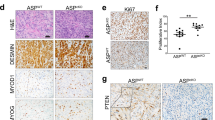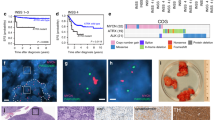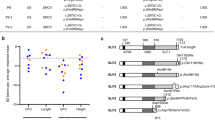Abstract
Chromosome 3q alterations occur frequently in many types of tumours. In a genetic screen for loci present in rhabdomyosarcomas, we identified an isochromosome 3q [i(3q)], which inhibits muscle differentiation when transferred into myoblasts. The i(3q) inhibits MyoD function, resulting in a non-differentiating phenotype. Furthermore, the i(3q) induces a ‘cut’ phenotype, abnormal centrosome amplification, aneuploidy and loss of G1 arrest following γ-irradiation. Testing candidate genes within this region reveals that forced expression of ataxiatelangiectasia and rad3-related (ATR) results in a phenocopy of the i(3q). Thus, genetic alteration of ATR leads to loss of differentiation as well as cell-cycle abnormalities.
This is a preview of subscription content, access via your institution
Access options
Subscribe to this journal
Receive 12 print issues and online access
$209.00 per year
only $17.42 per issue
Buy this article
- Purchase on Springer Link
- Instant access to full article PDF
Prices may be subject to local taxes which are calculated during checkout
Similar content being viewed by others
References
Dias, P., Parham, D.M., Shapiro, D.N., Webber, B.L. & Houghton, P.J. Myogenic regulatory protein (MyoD1) expression in childhood solid tumours: diagnostic utility in rhabdomyosarcoma. Am. J. Pathol. 137, 1283–1291 (1990).
Scrable, H.J., Johnson, D.K., Rinchik, E.M. & Cavenee, W.K. Rhabdomyosarcoma-associated locus and MYOD1 are syntenic but separate loci on the short arm of human chromosome 11. Proc. Natl. Acad. Sci. USA 87, 2182–2186 (1990).
Weintraub, H. et al. Activation of muscle-specific genes in pigment, nerve, fat, liver, and fibroblast cell lines by forced expression of MyoD. Proc. Natl. Acad. Sci. USA 86, 5434–5438 (1989).
Tapscott, S.J., Thayer, M.J. & Weintraub, H. Deficiency in rhabdomyosarcomas of a factor required for MyoD activity and myogenesis. Science 259, 1450–1453 (1993).
Barr, F.G. et al. Rearrangement of the PAX3 paired box gene in the paediatric solid tumour alveolar rhabdomyosarcoma. Nature Genet. 3, 113–117 (1993).
Mitchell, C.D., Ventris, J.A., Warr, T.J. & Cowell, J.K. Molecular definition in a somatic cell hybrid of a specific 2:13 translocation breakpoint in childhood rhabdomyosarcoma. Oncogene 6, 89–92 (1991).
Shapiro, D.N., Sublett, J.E., Li, B., Downing, J.R. & Naeve, C.W. Fusion of PAX3 to a member of the forkhead family of transcription factors in human alveolar rhabdomyosarcoma. Cancer Res. 53, 5108–5112 (1993).
Davis, R.J., D'Cruz, C.M., Lovell, M.A., Biegel, J.A. & Barr, F.G. Fusion of PAX7 to FKHR by the variant t(1;13)(p36;q14) translocation in alveolar rhabdomyosarcoma. Cancer Res. 54, 2869–2872 (1994).
Bentley, N.J. et al. The Schizosaccharomyces pombe rad3 checkpoint gene. EMBO J. 15, 6641–6651 (1996).
Sanchez, Y. et al. Regulation of RAD53 by the ATM-like kinases MEC1 and TEL1 in yeast cell cycle checkpoint pathways. Science 271, 357–360 (1996).
Hari, K.L. et al. The mei-41 gene of D. melanogaster is a structural and functional homolog of the human ataxia telangiectasia gene. Cell 82, 815–821 (1995).
Keegan, K.S. et al. The Atr and Atm protein kinases associate with different sites along meiotically pairing chromosomes. Genes Dev 10, 2423–2437 (1996).
Cimprich, K.A., Shin, T.B., Keith, C.T. & Schreiber, S.L. cDNA cloning and gene mapping of a candidate human cell cycle checkpoint protein. Proc. Natl. Acad. Sci. USA 93, 2850–2855 (1996).
Fiddler, T.A., Smith, L., Tapscott, S.J. & Thayer, M.J. Amplification of MDM2 inhibits MyoD-mediated myogenesis. Mol. Cell. Biol. 16, 5048–5057 (1996).
Fournier, R.E.K. A general high-efficiency procedure for production of microcell hybrids. Proc. Natl. Acad. Sci. USA 78, 6349–6353 (1981).
Peterson, C.A., Gordon, H., Hall, Z.W., Paterson, B.M. & Blau, H.M. Negative control of the helix-loop-helix family of myogenic regulators in the NFB mutant. Cell 62, 493–502 (1990).
Fukasawa, K., Choi, T., Kuriyama, R., Rulong, S. & Vande-Woude, G.F. Abnormal centrosome amplification in the absence of p53. Science 271, 1744–1747 (1996).
Hirano, T., Funahashi, S., Uemura, T. & Yanagida, M. Isolation and characterization of Schizosaccharomyces pombe cut mutants that block nuclear division but not cytokinesis. EMBO J. 5, 2973–2979 (1986).
Maltzman, W. & L UV irradiation stimulates levels of p53 cellular tumour antigen in nontransformed mouse cells. Mol. Cell. Biol. 4, 1689–1694 (1984).
Barak, Y., Juven, T., Haffner, R. & Oren, M. mdm2 expression is induced by wild type p53 activity. EMBO J. 12, 461–468 (1993).
Wu, X., Bayle, J.H., Olson, D. & Levine, A.J. The p53-mdm-2 autoregulatory feedback loop. Genes Dev. 7, 1126–1132 (1993).
el-Deiry, W.S. et al. WAF1, a potential mediator of p53 tumour suppression. Cell 75, 817–825 (1993).
Deng, C., Zhang, P., Harper, J.W., Elledge, S.J. & Leder, P. Mice lacking p21CIP1/WAF1 undergo normal development, but are defective in G1 checkpoint control. Cell 82, 675–684 (1995).
Donehower, L.A. et al. Mice deficient for p53 are developmentally normal but susceptible to spontaneous tumours. Nature 356, 215–221 (1992).
Olson, E.N. Interplay between proliferation and differentiation within the myogenic lineage. Dev. Biol. 154, 261–272 (1992).
Lassar, A.B., Skapek, S.X. & Novitch, B. Regulatory mechanisms that coordinate skeletal muscle differentiation and cell cycle withdrawal. Curr. Opin. Cell Biol. 6, 788–794 (1994).
Benezra, R., Davis, R.L., Lockshon, D., Turner, D.L. & Weintraub, H. The protein Id: a negative regulator of helix-loop-helix DNA binding proteins. Cell 61, 49–59 (1990).
Li, L. et al. FGF inactivates myogenic helix-loop-helix proteins through phosphorylation of a conserved protein kinase C site in their DNA-binding domains. Cell 71, 1181–1194 (1992).
Hardy, S., Kong, Y. & Konieczny, S.F. Fibroblast growth factor inhibits MRF4 activity independently of the phosphorylation status of a conserved threonine residue within the DNA-binding domain. Mol. Cell. Biol. 13, 5943–5956 (1993).
Rao, S.S., Chu, C. & Kohtz, D.S. Ectopic expression of cyclin D1 prevents activation of gene transcription by myogenic basic helix-loop-helix regulators. Mol. Cell. Biol. 14, 5259–5267 (1994).
Skapek, S.X., Rhee, J., Spicer, D.B. & Lassar, A.B. Inhibition of myogenic differentiation in proliferating myoblasts by cyclin D1-dependent kinase. Science 267, 1022–1024 (1995).
Hawley, R.S. & Friend, S.H. Strange bedfellows in even stranger places: the role of ATM in meiotic cells, lymphocytes, tumours, and its functional links to p53. Genes Dev. 10, 2383–2388 (1996).
Hoekstra, M.F. Responses to DNA damage and regulation of cell cycle checkpoints by the ATM protein kinase family. Curr. Opin. Genet. Dev. 7, 170–175 (1997).
Carr, A.M. Control of cell cycle arrest by the Mec1sc/Rad3sp DNA structure checkpoint pathway. Curr. Opin. Genet. Dev. 7, 93–98 (1997).
Bishop, J.M. The molecular genetics of cancer. Science 235, 305–311 (1987).
Elledge, S.J. Cell cycle checkpoints: preventing an identity crisis. Science 274, 1664–1672 (1996).
Forozan, F., Karhu, R., Kononen, J., Kallioniemi, A. & Kallioniemi, O.P. Genome screening by comparative genomic hybridization. Trends Genet. 13, 405–409 (1997).
Weber-Hall, S. et al. Gains, losses, and amplification of genomic material in rhabdomyosarcoma analysed by comparative genomic hybridization. Cancer Res. 56, 3220–3224 (1996).
Speicher, M.R. et al. Comparative genomic hybridization detects novel deletions and amplifications in head and neck squamous cell carcinomas. Cancer Res. 55, 1010–1013 (1995).
Carey, T.E., Worsham, M.J. & Van-Dyke, D.L. Chromosomal biomarkers in the clonal evolution of head and neck squamous neoplasia. J. Cell. Biochem. Suppl. 213–222 (1993).
Jin, Y. et al. Chromosome abnormalities in eighty-three head and neck squamous cell carcinomas: influence of culture conditions on karyotypic pattern. Cancer Res. 53, 2140–2146 (1993).
Rao, P.H., Sreekantaiah, C., Schantz, S.P. & Chaganti, R.S. Cytogenetic analysis of 11 squamous cell carcinomas of the head and neck. Cancer Genet. Cytogenet. 77, 60–64 (1994).
Ried, T. et al. Mapping of multiple DNA gains and losses in primary small cell lung carcinomas by comparative genomic hybridization. Cancer Res. 54, 1801–1806 (1994).
Rabbitts, P., Bergh, J., Douglas, J., Collins, F. & Waters, J. A submicroscopic homozygous deletion at the D3S3 locus in a cell line isolated from a small cell lung carcinoma. Genes Chromosom. Cancer 2, 231–238 (1990).
Heselmeyer, K. et al. Gain of chromosome 3q defines the transition from severe dysplasia to invasive carcinoma of the uterine cervix. Proc. Natl. Acad. Sci. USA 93, 479–484 (1996).
Lengauer, C., Kinzler, K.W. & Vogelstein, B. Genetic instability in colorectal cancers. Nature 386, 623–627 (1997).
Lugo, T.G., Handelin, B., Killary, A.M., Housman, D.E. & Fournier, R.E. Isolation of microcell hybrid clones containing retroviral vector insertions into specific human chromosomes. Mol. Cell. Biol. 7, 2814–2820 (1987).
Favaloro, J., Freisman, R. & Kamen, R. Transcription maps of polyoma virus-specific RNA: analysis by two dimensional nuclease S1 gel mapping. Methods Enzymol. 65, 718–749 (1980).
Rupp, R.A. & Weintraub, H. Ubiquitous MyoD transcription at the midblastula transition precedes induction-dependent MyoD expression in presumptive mesoderm of X.laevis. Cell 65, 927–937 (1991).
Yunis, J.J. & Chandler, M.E. High-resolution chromosome analysis in clinical medicine. Prog. Clin. Pathol. 7, 267–288 (1978).
Trask, B. & Pinkel, D. Flow cytometry (Academic Press, New York, 1990).
Author information
Authors and Affiliations
Corresponding author
Rights and permissions
About this article
Cite this article
Smith, L., Liu, S., Goodrich, L. et al. Duplication of ATR inhibits MyoD, induces aneuploidy and eliminates radiation-induced G1 arrest. Nat Genet 19, 39–46 (1998). https://doi.org/10.1038/ng0598-39
Received:
Accepted:
Issue Date:
DOI: https://doi.org/10.1038/ng0598-39
This article is cited by
-
Persistent polyclonal binucleated B-cell lymphocytosis and MECOM gene amplification
BMC Research Notes (2016)
-
Analysis of functional germline variants in APOBEC3 and driver genes on breast cancer risk in Moroccan study population
BMC Cancer (2016)
-
ATR inhibition preferentially targets homologous recombination-deficient tumor cells
Oncogene (2015)
-
Clinical implication of centrosome amplification and expression of centrosomal functional genes in multiple myeloma
Journal of Translational Medicine (2013)
-
Long-term follow-up of 111 patients with persistent polyclonal B-cell lymphocytosis with binucleated lymphocytes
Leukemia (2009)



